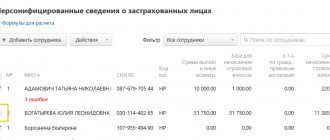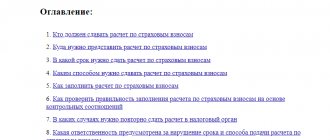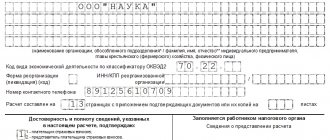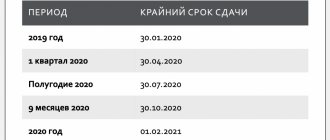If employee data does not need to be adjusted
In this case, the report includes only data on the organization with the adjustment number on the title page. There is no need to include employee data in the report. To remove employees from the report, uncheck them in Section 3.
If Section 1 is in automatic calculation mode, be sure to update the list of employees. For example, Kontur.Extern calculates amounts for all employees in the list, regardless of whether they are selected or unchecked. Check the box only for those employees who should be included in the adjustment report.
Also, in some systems, for example in Externa, amounts for employees and for the organization are reconciled only in the original report. To check the adjustment, use the following algorithm.
Algorithm for checking a corrective report
- Remove the correction number from the title page, if it is there.
- Update the list of employees in Section 3.
- Set the fields in Section 1 applications to automatic mode.
- Check the relevance of the data in previous periods.
- If the data is not up to date, download reports in pre-import mode into the service.
- Run the scan. Correct errors if any.
- Put the correction number on the title page.
- Generate and send a report.
If you report through Kontur.Extern, the task is simpler. The system will warn you if you try to send a report with the details of a previously sent report. Here are some tips:
- If the Federal Tax Service has accepted the initial report and you want to send an adjustment, the system will tell you which number you need to indicate.
- If the initial report has not yet been accepted, Extern will inform you that it is too early to send the adjustment and will advise you to wait for a response from the Federal Tax Service.
- If the primary report is rejected, Extern will warn you that before sending the adjustment you must submit the primary report with number = 0.
Reporting through another system? Connect to Extern with a 50% discount (not valid in all regions).
Catch a discount
How to delete section 3 in RSV
The Federal Tax Service of Russia issued a letter No. BS-4-11/ [email protected] , in which it explained how to fill out an updated calculation of insurance premiums if Section 3 of the calculation “Personalized information about insured persons” is filled out incorrectly. The Tax Department indicated that the procedure for filling out the adjusted calculation depends on the nature of the errors.
If errors concern the personal data of insured individuals, then section 3 is completed as follows. For each insured person with identified errors, in the corresponding lines of subsection 3.1 of the calculation, the personal data that is reflected in the initial calculation is indicated and at the same time in subsection 3.2 on lines 190-300, “0” is indicated in all acquaintances. Then, in relation to this person, subsection 3.1 is filled out again, but indicating correct (up-to-date) personal data, as well as lines 190 - 300 of subsection 3.2 with the indicators from the original calculation (if this subsection was initially filled out correctly). If, when correcting personal data, it simultaneously becomes necessary to adjust the indicators for individuals specified in subsection 3.2, then the correct data is reflected in this subsection, and, if necessary, section 1 of the calculation is adjusted.
Other errors made in section 3 of the calculation (with the exception of personal data) are corrected in the following order:
If the organization forgot to include data on individual individuals in the initial calculation, then in the updated calculation Section 3 is filled out in relation to these individuals and at the same time Section 1 is adjusted.
If the organization erroneously reflected in subsection 3.2 of the initial calculation data on individuals who should not be in the calculation, then in the updated calculation in relation to such persons section 3 is filled out. In this case, in lines 190 - 300 of subsection 3.2 of the calculation, “0” is indicated in all acquaintances. At the same time, section 1 of the calculation is adjusted.
If it is necessary to correct data that is incorrectly reflected in subsection 3.2 of the initial calculation for individual individuals, then section 3 with the correct indicators in subsection 3.2 in relation to such individuals is included in the updated calculation, and if necessary, section 1 of the calculation is adjusted.
Don't miss the latest news - subscribe to the site's free newsletter:
- dozens of experts daily monitor changes in legislation and judicial practice;
- you subscribe only to those categories of news that you want to receive;
- mailing is free, regardless of the existence of a 1C:ITS agreement;
If you find that in the calculation of insurance premiums submitted and already accepted by the Federal Tax Service, errors were made in section 3 “Personalized information about insured persons”, in the updated calculation section 3 must be filled out twice.
The first time section 3 in the clarification is filled out in order to cancel incorrect data. To do this, in subsection 3.1 of the updated DAM, personal data is indicated in the same form in which they were included in the initial calculation. In this case, in lines 190 - 300 of subsection 3.2, containing total indicators, zeros are entered, and in “non-total” lines a dash is entered. In line 010 of section 3 of the updated calculation, the adjustment number “1–” is indicated. In lines 160 – 180 of subsection 3.1, sign “2” should be reflected - not an insured person.
When filling out the second section 3 in subsection 3.1 you will need to indicate the correct (up-to-date) personal data of the insured persons. Subsection 3.2 is filled out in the generally established manner (i.e., reflecting the total indicators). In line 010 of section 3 of the updated DAM, the adjustment number “0–” is indicated. In lines 160 - 180 of subsection 3.1, the code “1” or “2” is indicated, depending on whether the person is insured or not.
Please note that if the essence of adjusting personal data in the calculation is to remove data on “extra” individuals from the DAM, you only need to fill out one section 3 (zeroing).
It remains to be noted that according to the Tax Code, if unreliable personal data identifying the insured persons is indicated in the calculation, the DAM is considered not provided (Clause 7, Article 431 of the Tax Code). So the procedure for presenting clarifications described above probably refers to periods when tax authorities still accepted calculations with such errors due to incorrectly transmitted SNILS data from the Pension Fund.
In 2021, a new report has appeared for employers - calculation of insurance premiums.
When filling out the new form, according to tax officials, policyholders made many mistakes. Therefore, the letter of the Federal Tax Service dated June 28, 2017 No. BS-4-11 / [email protected] describes the procedure for correcting them.
If you need to adjust data on employees in Section 3 (except for full name and SNILS)
On the title page, indicate the correction number (for example, “1—,” “2—,” and so on). According to the filling procedure, include in the form only those employees for whom you need to correct the data.
For each employee, indicate the adjustment number, keeping the serial numbers. Unused numbers can be added to new employees.
Please note: checks in the service work for all employees only if the title has an adjustment number = 0. To check the report, use the above algorithm.
Please indicate the correction number on the title page. For example, “1—”, “2—”, etc. Then create two employee cards and send them in one calculation:
- With incorrect SNILS, zero (deleted) Subsection 3.2 and adjustment number “1”. In lines 160-180, indicate the sign “no”.
- With the correct SNILS, correct amounts in Subsections 3.2.1 and 3.2.2, adjustment number “0” and a new serial number of the employee (not previously used).
If the error in the full name and SNILS was formatted and last quarter it was possible to send a report with it, but now it is not (for example, numbers and dashes in the full name, spaces at the end of the full name, incorrect SNILS), check with the inspector what to do.
Example 1: SNILS is not the same, but real
In the original report, instead of Ivanov Ivan Ivanovich working in the organization with SNILS 001-001-002 13, Ivanov Ivan Ivanovich with SNILS 001-001-001 12 was indicated. Both SNILS numbers exist and can be loaded into the Federal Tax Service database.
To prepare the adjustment, we create two employee cards. The first is with an error that needs to be corrected, the second is with data that should be in the report.
On the first card in Section 3, tick Ivanov Ivan Ivanovich with SNILS number 001-001-001 12. In his card:
- Specify a non-zero adjustment number;
- In lines 160-180, mark “No”;
- Remove section 3.2.
In the second card in Section 3, tick Ivan Ivanovich Ivanov with SNILS number 001-001-002 13. In his card:
- specify the correction number = 0;
- Fill in the correct information for the remaining positions.
Example 2: non-existent SNILS
In the original report, instead of Ivanov Ivan Ivanovich working in the organization with SNILS 001-001-001 12, Ivanov Ivan Ivanovich @ was indicated! with SNILS 001-001- 002 18.
Such SNILS should not pass the check for the control ratio, and the full name should not be checked according to the scheme. The Federal Tax Service should not have accepted such a report. If this happens, contact the inspector for clarification.
When do you need an updated calculation of insurance premiums?
The updated DAM should be submitted (Article 81 of the Tax Code of the Russian Federation) in the following cases:
- If the original calculation contains errors. First of all, this concerns those errors that resulted in an underestimation of contributions to be transferred to the tax office. For example, the fee payer mistakenly indicated the wrong amount. It needs to be adjusted in the updated RSV.
- If any information is not reflected in the initial calculation or is not reflected in full. For example, Section 3 does not show all insured persons.
If errors were found in the initial calculation that did not result in an underestimation of the amount of contributions, it is not necessary to submit an updated report (this rule does not apply to errors regarding insured persons in section 3).
Cases in which it is necessary to clarify the calculation are also listed in the order in which the DAM is completed (clause 1.2).
When submitting clarifications on contributions, you should take into account one important nuance: the clarification must be submitted on the form used in the period in which errors were found.
If you forgot to include an employee in the original report
Include the forgotten employee in the adjustment form with the adjustment number in the employee card = 0. The amounts in Section 1 and Appendices 1 and 2 to Section 1 change taking into account this employee and are indicated as they should be throughout the organization).
Please note that each time you send a new correction, you must put a new number on the title page.
Report for employees through Kontur.Extern. Loading data into RSV from SZV-M. Importing data from 2-NDFL 5.06. Zero RSV in no time. Free for 3 months.
Register
How to correct errors made before January 1, 2021
Since the transition to the administration of insurance premiums took place not so long ago, it may be necessary to make adjustments in those periods when the calculation of insurance premiums was submitted to the Pension Fund. In those years, a different report form was in effect (for comparison, you can download the PFR form RSV-1 below). How to make an adjustment to RSV-1 for 2021 in 2021?
This report, which was in use until 2021, included not only information about the calculation of payments to the Pension Fund and the Compulsory Medical Insurance Fund, but also information about the insurance experience of each employee.
If errors were discovered in the calculation of insurance premiums before 01/01/2017, then to correct them it is necessary not only to submit the corrective report RSV-1 for 2021 in 2021. The Pension Fund must submit:
- adjustment of RSV-1 without section 6 (it reflected individual information about employees);
- SZV-KORR (intended for making corrections to individual information);
- EDV-1 form (list of documents provided and summary data for the adjusted period).
To correct the error in 2021, you must fill out the calculation of insurance premiums that was valid in that period. On the title page, indicate the adjustment number and information about the period being adjusted. You must fill out the “reason for clarification” field. If an error in the amount of accrued insurance premiums is corrected, you need to enter “2”. Reflect additional accrued amounts in line 120 of section 1.
If you included one employee instead of another
Both employees must be included in the corrective report:
- Unnecessary - with zero (removed) Subsection 3.2 and adjustment number “1”. In lines 160-180, indicate the sign “no”.
- Required - with correct data, correct amounts in Subsections 3.2.1 and 3.2.2 and adjustment number “0”.
Section 1 with Subsections 1 and 2 needs to be adjusted: subtract the amounts of the erroneously added employee from the total amounts of the organization and add the amounts for the employee who was forgotten to be included.
When to fill out section 3 of the RSV
Section 3 of the calculation of insurance premiums is filled out for each employee in the following cases:
- an employment or civil contract has been concluded with the employee;
- the employee is on leave without pay;
- the employee is on maternity leave (in this case there is no need to form subsection 3.2, since insurance premiums are not calculated from benefits);
- even if the organization has only one employee - the director, who is also the founder - the section must be filled out.
Attention! If an employer submits a calculation of insurance premiums to the Federal Tax Service without completing Section 3, the tax authorities will not accept it. It will be considered that the document is not fully formed, that is, it does not comply with legal norms. If you use the 1C:Reporting service, you will receive a notification in the service to the previously specified document recipient account.
If the right to apply a reduced tariff has been acquired/lost (recalculation of contributions from the beginning of the year)
In the clarifying calculations for previous reporting periods in Appendix 1, indicate the new tariff code (08/02). Change the contribution amounts in Section 1 and Appendices 1 and 2 to Section 1 to take into account the new tariff.
All employees must be included in the corrective report. In each employee’s card, indicate an adjustment number other than 0, maintaining the serial numbers of the employees. In Subsection 3.2.1 you need to indicate two categories of the insured person (NR and PNED):
- the old category with zero amounts.
- a new category with the correct amounts.
When is it necessary to submit an updated calculation?
The payer is obliged to make the necessary changes and submit an updated calculation to the tax authority in the manner prescribed by Art. Tax Code of the Russian Federation, if the following facts are discovered in the calculation submitted by it (clause 1.2 of the Procedure for filling out calculations for insurance premiums, approved by Order of the Federal Tax Service of Russia dated October 10, 2016 No. ММВ-7-11 / [email protected] , hereinafter - the Procedure):
- non-reflection or incomplete reflection of information;
- errors that lead to an underestimation of the amount of insurance premiums payable;
- as well as recalculation of the base for the previous period towards a decrease, such explanations are given by the Federal Tax Service in a letter dated 08/24/2017 No. BS-4-11/ [email protected]
If the base for calculating insurance premiums for previous reporting periods is adjusted, the payer submits an updated calculation for this period. The calculation for the current reporting period does not reflect the amount of recalculation made for the previous period. When filling out calculation line indicators, negative values are not provided (section II “General requirements for the procedure for filling out the Calculation” of the Procedure).
Beginning with 9-month reporting, files containing negative amounts will be considered inconsistent with the format. Such changes were made by the Federal Tax Service to the xml file schema. And those who submitted calculations for the first half of the year with negative amounts will have to submit an updated calculation for the first quarter (the tax authorities are sending out the relevant requirements).
Let’s say that in July they recalculated vacation pay for June to an employee who quit. The result was a negative basis and assessed contributions. It is necessary to submit to the Federal Tax Service an updated calculation for the six months with reduced amounts, and in the calculation for 9 months, take this into account in the columns “Total from the beginning of the billing period.”
Changes to the Labor Code of the Russian Federation, personal income tax and wages. Watch the reports of representatives of regulatory authorities at Kontur.Conference-2018
To learn more







